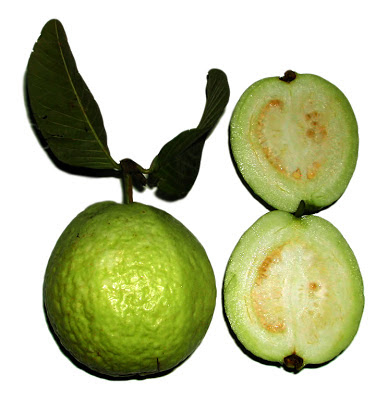The genus Psidium ( guava in a broad sense, properly the name of guava refers to the most economically important species, Psidium guajava ) includes a hundred species of trees and shrubs of the Myrtaceae.
The leaves are opposite, simple, ovate, 5-15 cm long. The flowers are white, with five petals and numerous stamens. The fruits are edible, round or pear-shaped, long from 3 to 12 cm depending on the species and variety. The thin skin of different colors depending on the species, hides a creamy flesh with many seeds small and hard.
Cultivation and uses
Guavas are cultivated in many countries of the tropics for its edible fruits subtropical. Several species are grown commercially. The most important are in the table at right. The fruit is eaten whole, as an apple , or sliced and served with sugar and cream for dessert. In Asia , the raw guava is dipped in salt or powder prune.
The boiled guava is also extensively used to make candies, jellies, jams and juices. It is one of the fruits with higher levels of vitamin C per gram contains about 6 or 7 times the orange, which makes it a naturally influenza. The leaves and bark are astringent intestinal diarrhea especially in children, since they are rich in tannin, 30g of leaves per 150ml of water, the cooking is employed to wash ulcers. The root bark of guava is a good tonic to cure nerve weakness and anemia, often taking the cooking. Natural abundance of fresh produce are 273 pieces in 100g.
~~~
~~~
The leaves are opposite, simple, ovate, 5-15 cm long. The flowers are white, with five petals and numerous stamens. The fruits are edible, round or pear-shaped, long from 3 to 12 cm depending on the species and variety. The thin skin of different colors depending on the species, hides a creamy flesh with many seeds small and hard.
Cultivation and uses
Guavas are cultivated in many countries of the tropics for its edible fruits subtropical. Several species are grown commercially. The most important are in the table at right. The fruit is eaten whole, as an apple , or sliced and served with sugar and cream for dessert. In Asia , the raw guava is dipped in salt or powder prune.
The boiled guava is also extensively used to make candies, jellies, jams and juices. It is one of the fruits with higher levels of vitamin C per gram contains about 6 or 7 times the orange, which makes it a naturally influenza. The leaves and bark are astringent intestinal diarrhea especially in children, since they are rich in tannin, 30g of leaves per 150ml of water, the cooking is employed to wash ulcers. The root bark of guava is a good tonic to cure nerve weakness and anemia, often taking the cooking. Natural abundance of fresh produce are 273 pieces in 100g.
~~~
~~~



No comments:
Post a Comment